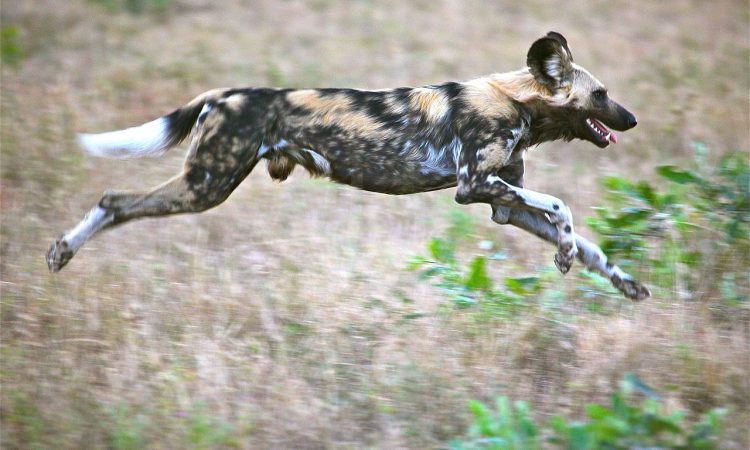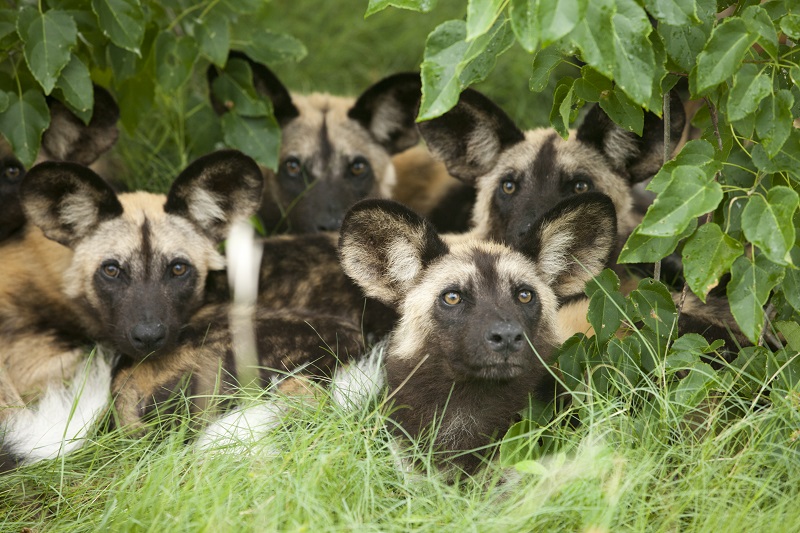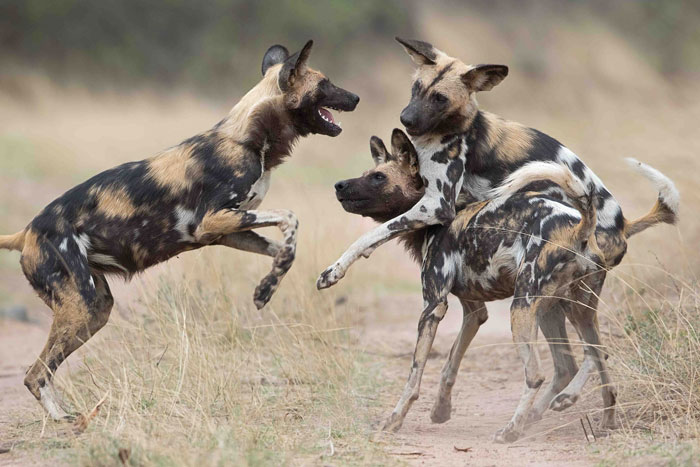Facts About the African wild Dog : The African wild dog is a very gregarious and clever creature. The African wild dog, whose Latin name, Lycaonpictus, means “painted wolf-like animal,” is one of the most endangered mammals in the world. It may be recognized by its long legs and uneven hair patterns. Wild dogs are extremely sociable, live in groups, and are known to aid other pack members who are sick or frail. The same is true for hunting, when groups of up to 20 can cooperate. When they reach adulthood, males remain with their original pack while females typically look for a new pack. The following are some of the quick facts about Africa wild dogs:

Identification
These species, unlike other dogs, may be clearly recognized while on a safari thanks to their big bat-like ears, painted color, and the presence of four toes on both feet.
Habitat
Once widespread over the continent of Africa, African wild dogs are now rare and can only be found in arid regions, savannas, and grasslands. They can also be found in settings like woodlands and mountains, where their prey resides. They congregate in packs to live and hunt.

Behavior
African wild dogs are social canids and this indicates that they reside in a “pack,” a social unit. A pack may have two to twenty-seven, seldom as much as a hundred, and members. They have a great deal of devotion and loyalty towards the other pack members. They have strong hearing and smelling senses, but they have very weak vision and cannot even spot stationary prey that is properly hidden.
A social life that is rich and complex
Since they are highly gregarious animals, packs are everything to African wild dogs. A monogamous male and female breeding couple known as the “alpha” pair often rules these packs, with the female holding the position of leadership. A good hunting and breeding group needs at least six members, although a single pack can have as few as two or as many as 30 painted dogs. Wild dog packs have been seen to occupy areas larger than one thousand square kilometers in some parks.
The alpha female selects the location for her pack’s den and, with the aid of her pack, excavates it. The female may also decide to build her nest in an abandoned aardvark lair, but she will make sure it is well hidden and will provide many escape routes in case of an emergency. The entire pack takes care of the female’s puppies as well.
These dogs spend most of their time together and have close familial ties. Dogs frequently engage with one another and use touch, body language, and vocalizations to communicate. Protecting their pack is always their top priority. Pups are fed first after a kill; “aunties” look after the pups of other mothers; and if a wild dog gets sick or hurt, their pack mates come to their aid.
Reproduction
Within a group, only the alpha male and alpha female are in charge of breeding, with the others helping to care for the pups. Strength and aggression determine the male and female alphas. Occasionally, more than one female may breed in larger packs. An alpha female may occasionally kidnap and kill the pups of another female.
The African wild dogs have no specific mating season. Although there may be an upsurge in mating in the latter rainy season between March and June, A female will choose an underground burrow after a gestation period of about 70 days and give birth to a litter of about 10 pups (few will survive to adulthood). Each individual in the pack is in charge of providing for the pups, including protection and feeding them after a successful hunt.
Hunting techniques
Crepuscular in nature, African wild dogs are active in the early morning and late at night. Due to the fact that they hunt in groups, they are regarded as the most successful hunters. Nevertheless, adults and seasoned hunters can go hunting alone.
They have a reputation as vicious hunters. This is because they consume their prey while it is still alive, and the prey will die from shock and blood loss. Since the social structure is clearly defined, there is less chance of hostility and intimidation during dining. Even the alpha males and females of the packs will give preference to pups who are able to eat solid foods. By having the weak, elderly, or damaged puppies and the pup-sitter regurgitate food, hunters bring food back to them.
One of the most endangered large carnivores on the planet
The most targeted predator in Africa is the painted wolf. Approximately 500 000 painted wolves were present in 39 African nations a century ago. The most vigorous populations still exist in the southern region of the continent. Today, they are all but extinct in the west and struggling in the east. Only 1400 of their estimated less than 7 000 members—who are divided into 39 different subpopulations—are mature adults. On the IUCN Red List, they are listed as endangered, and their population is steadily shrinking.

Where to see African Wild dogs?
African wild dogs are a nomadic species, and they have enormous home ranges; packs in the Serengeti are thought to span an area of 900 square miles apiece. Typically, the African Wild Dog can be found in the following countries:
- Angola
- Benin
- Botswana
- Burkina Faso
- The Central African Republic
- Chad
- Ethiopia
- Kenya
- Malawi
- Mozambique
- Namibia
- Niger
- Senegal
- South Africa
- South Sudan
- Tanzania
- Zambia
- Zimbabwe
DID YOU KNOW?
- Before going on a hunt, African wild dogs perform a ceremony. Yes, they stimulate one another by moving around, talking, and touching each other until they become enthusiastic and go hunting.
- Due to their extensive communication, African wild dog packs have an 80% success rate in their hunting endeavors.
- In the wild, African wild dogs typically live to be 11 years old.
- Similar to a greyhound, the African wild dog can run up to 44 mph.
- The muscles that enable the big, rounded ears of the African wild dog to rotate give it exceptional hearing.
- The African wild dog has not been domesticated by humans because of its strong loyalty to its species and habitat.
- African wild canines give birth in abandoned warthog and porcupine dens underground.
- When it comes to food, puppies are prioritized above dominant pack members.
- African wild dogs will regurgitate meat for any puppies in their litter after a hunt.


